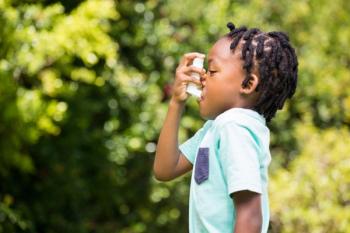
Idiopathic Palmoplantar Hidradenitis
For 3 days, a 6-year-old boy had nonpruritic, painful lesions on the soles of both feet. His mother reported that he had difficulty in sleeping and walking but had no fever or other systemic symptoms.
Figure
For 3 days, a 6-year-old boy had nonpruritic, painful lesions on the soles of both feet. His mother reported that he had difficulty in sleeping and walking but had no fever or other systemic symptoms. The child had been in a hot tub the day before the lesions developed. He had a history of asthma and allergies. His current medications included montelukast, budesonide inhaler, and loratadine. His family history was unremarkable.
Vital signs were normal. Multiple violaceous, warm, tender nodules were noted on the plantar surfaces of both feet. The lesions were distributed mostly over the metatarsal bones. On one foot, an erythematous streak extended across the sole. Both extremities demonstrated full range of motion and strength with normal pulses and sensation.
Idiopathic palmoplantar hidradenitis was diagnosed. The patient was given 5 mg of hydrocodone, which greatly reduced his pain. No laboratory or other studies were obtained.
Painful, violaceous, nodular lesions that appear on the soles and occasionally on the palms in children and young adults are characteristic of palmoplantar hidradenitis.1 These may be accompanied by low-grade fever.1,2 Frequently, there is a history of recent hot tub use, sometimes with coexistent hot tub folliculitis. 2 Other epidemiological and historical associations include use of a sauna or swimming pool,3,4 wearing wet footwear,2,5 vigorous physical activity,5 beach vacations,6 and occurrence during fall or spring.1
An association with Pseudomonas aeruginosa has been suggested.3,4 In one study, P aeruginosa was isolated from contaminated pool water and the folliculitis of children in whom hot hand-foot syndrome was diagnosed. 3P aeruginosa has not been isolated from any patient with palmoplantar hidradenitis; however, the authors noted the similarity between this condition and hot hand-foot syndrome and speculated that they may be the same entity.3 They also believe that microtrauma of the thinner stratum corneum epidermis in children leaves their palms and soles particularly susceptible to invasion by P aeruginosa.3
The diagnosis of palmoplantar hidradenitis is clinical.1 Results of basic blood tests are often normal, have been used empirically,2 the lesions often resolve within 1 to several weeks without any specific care, other than rest to reduce pain on ambulation.
This patient was discharged in good condition with a prescription for hydrocodone. A 7-day regimen of cephalexin was also prescribed because the erythematous streak suggested the possibility of ascending lymphangitis.
References:
- Simon M Jr, Cremer H, von den Driesch P. Idiopathic recurrent palmoplantar hidradenitis in children. Report of 22 cases. Arch Dermatol. 1998;134:76-79.
- Rabinowitz LG, Cintra ML, Hood AF, Esterly NB. Recurrent palmoplantar hidradenitis in children. Arch Dermatol. 1995;131:817-820.
- Yu Y, Cheng AS, Wang L, et al. Hot tub folliculitis or hot hand-foot syndrome caused by Pseudomonas aeruginosa. J Am Acad Dermatol. 2007;57:596-600.
- Fiorillo L, Zucker M, Sawyer D, Lin AN. The pseudomonas hot-foot syndrome. N Engl J Med. 2001;345:335-338.
- Naimer SA, Zvulunov A, Ben-Amitai D, Landau M. Plantar hidradenitis in children induced by exposure to wet footwear. Pediatr Emerg Care. 2000;16:182-183.
- Laffitte E, Hohl D, Panizzon RG. Pseudomonas eccrine hidradenitis in a child revealing acute lymphoblastic leukemia [in French]. Ann Dermatol Venereol. 2004;131:975-978.
- Stahr BJ, Cooper PH, Caputo RV. Idiopathic plantar hidradenitis: a neutrophilic eccrine hidradenitis occurring primarily in children. J Cutan Pathol. 1994;21:289-296.
Newsletter
Access practical, evidence-based guidance to support better care for our youngest patients. Join our email list for the latest clinical updates.








